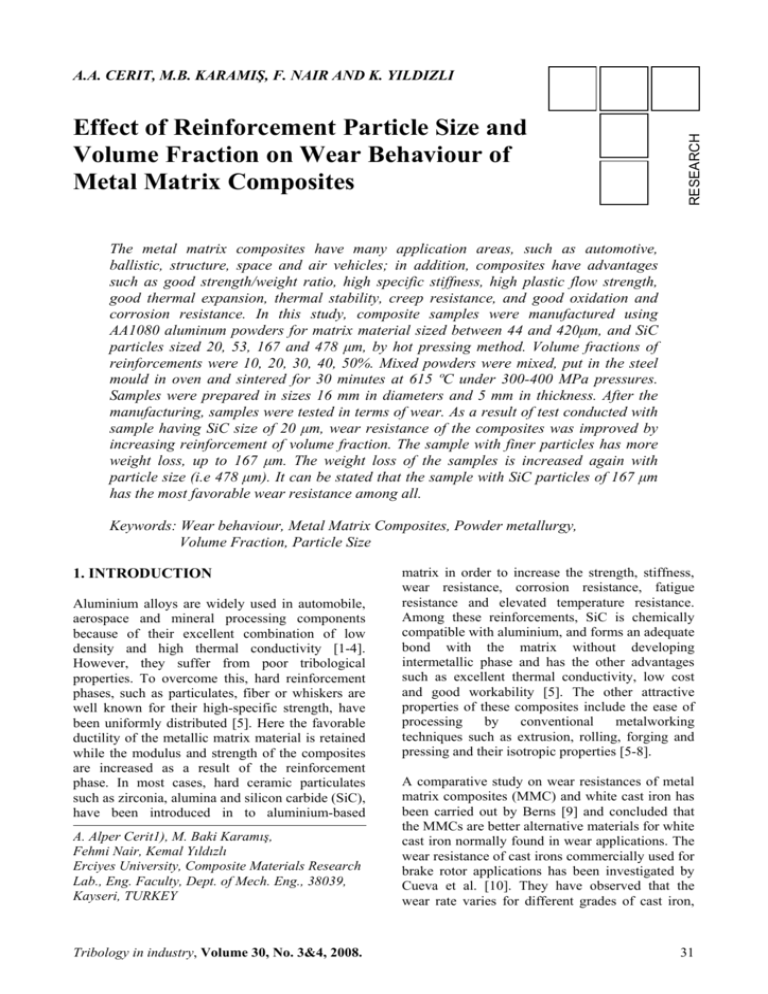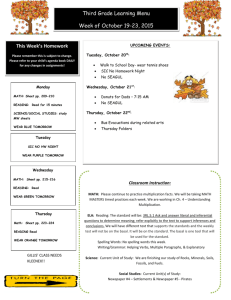Effect of Reinforcement Particle Size and Volume Fraction on Wear
advertisement

Effect of Reinforcement Particle Size and Volume Fraction on Wear Behaviour of Metal Matrix Composites RESEARCH A.A. CERIT, M.B. KARAMIŞ, F. NAIR AND K. YILDIZLI The metal matrix composites have many application areas, such as automotive, ballistic, structure, space and air vehicles; in addition, composites have advantages such as good strength/weight ratio, high specific stiffness, high plastic flow strength, good thermal expansion, thermal stability, creep resistance, and good oxidation and corrosion resistance. In this study, composite samples were manufactured using AA1080 aluminum powders for matrix material sized between 44 and 420μm, and SiC particles sized 20, 53, 167 and 478 μm, by hot pressing method. Volume fractions of reinforcements were 10, 20, 30, 40, 50%. Mixed powders were mixed, put in the steel mould in oven and sintered for 30 minutes at 615 ºC under 300-400 MPa pressures. Samples were prepared in sizes 16 mm in diameters and 5 mm in thickness. After the manufacturing, samples were tested in terms of wear. As a result of test conducted with sample having SiC size of 20 μm, wear resistance of the composites was improved by increasing reinforcement of volume fraction. The sample with finer particles has more weight loss, up to 167 μm. The weight loss of the samples is increased again with particle size (i.e 478 μm). It can be stated that the sample with SiC particles of 167 μm has the most favorable wear resistance among all. Keywords: Wear behaviour, Metal Matrix Composites, Powder metallurgy, Volume Fraction, Particle Size 1. INTRODUCTION Aluminium alloys are widely used in automobile, aerospace and mineral processing components because of their excellent combination of low density and high thermal conductivity [1-4]. However, they suffer from poor tribological properties. To overcome this, hard reinforcement phases, such as particulates, fiber or whiskers are well known for their high-specific strength, have been uniformly distributed [5]. Here the favorable ductility of the metallic matrix material is retained while the modulus and strength of the composites are increased as a result of the reinforcement phase. In most cases, hard ceramic particulates such as zirconia, alumina and silicon carbide (SiC), have been introduced in to aluminium-based matrix in order to increase the strength, stiffness, wear resistance, corrosion resistance, fatigue resistance and elevated temperature resistance. Among these reinforcements, SiC is chemically compatible with aluminium, and forms an adequate bond with the matrix without developing intermetallic phase and has the other advantages such as excellent thermal conductivity, low cost and good workability [5]. The other attractive properties of these composites include the ease of processing by conventional metalworking techniques such as extrusion, rolling, forging and pressing and their isotropic properties [5-8]. A. Alper Cerit1), M. Baki Karamış, Fehmi Nair, Kemal Yıldızlı Erciyes University, Composite Materials Research Lab., Eng. Faculty, Dept. of Mech. Eng., 38039, Kayseri, TURKEY A comparative study on wear resistances of metal matrix composites (MMC) and white cast iron has been carried out by Berns [9] and concluded that the MMCs are better alternative materials for white cast iron normally found in wear applications. The wear resistance of cast irons commercially used for brake rotor applications has been investigated by Cueva et al. [10]. They have observed that the wear rate varies for different grades of cast iron, Tribology in industry, Volume 30, No. 3&4, 2008. 31 and compact graphite iron is found to have more wear resistance. Zaidi and Senouci [11] investigated the real contact temperature and the friction coefficient of sliding surfaces. Czichos [12] suggested methods for presenting friction and wear data. Kennedy et al. [13] have investigated the tribological characteristics of several Cu based silicon carbide reinforced MMCs synthesised from coppercoated SiC particles. Lee et al.[14] investigated the effect of porosity, volume fraction and size of silicon carbide particles on the abrasion resistance of powder metallurgy aluminium alloy 6061 matrix composites. They found that the abrasion resistance of the aluminium alloy decreased drastically with increasing porosity. However, for the composites, the porosity effect was less significant. They also found that the abrasion resistance of the composites increased as the amount of SiC increased. Also for the composites containing the same amount of SiC reinforcements, the abrasion resistance increased by increasing the size of SiC particles. Axen et al. [15] studied the abrasion resistance of alumina fiber reinforced aluminium using a pinondrum abrasion wear tester. The composites were manufactured by a hot liquid infiltration technique. They concluded that fiber reinforcement significantly improved the abrasion resistance in milder abrasive situations, i.e., small and soft abrasives and low applied loads. However, in severe abrasive situations, the abrasion resistance of the composites was equal to or, in some cases, even lower than the unreinforced materials. thickness. The hardness of MMCs was measured by applying a load of 15 kg using Rockwell hardness tester (HRT). Then samples were tested by pin on ring tester aspect of wear (Fig. 1). 75 N constant load was applied on sample. Counterface was used in tests having hardness of 62 HRC. Wear surface of sample was examined using scanning electron microscope. Fig. 1. Schematic illustration of the wear testing machine : 1. Engine, 2. Tachometer, 3. Clutch, 4. Force sensor, 5. Sample holder, 6. Sample, 7. Counterface, 8. Weight holder, 9.Control unit, 10.Graphic plotter, 11.Heater 2. EXPERIMENTAL The discontinuous MMCs used in this study were prepared by hot pressing route, the matrix is closely confirmed to the AA1080 aluminium alloy and the reinforcement is silicon carbide (SiC) particulates (AA1080/SiC/vf). The chemical composition of matrix material is presented in Table 1. Composites containing 10–50 vol.% SiCp with particle sizes 20, 53, 167 and 478 μm were prepared by a conventional powder metallurgy (P/M) process, which involves the steps of mixing, degassing, hot pressing and sintering. Aluminium alloy powders were mixed along with various volume fraction and particle size of reinforcement. After being mixed, they were put into steel mould, and then sample was heated to 600 ˚C and sintered for 30 minutes under 400 MPa. Disc shaped samples have 16 mm diameter and 5 mm in 32 3. RESULTS AND DISCUSSIONS The hardness results of composite samples were shown in Fig. 2. On the one hand, hardness of the samples is increased by raising the volume fraction while particle size is constant. On the other hand, hardness of the samples is decreased by increasing the particle sizes. Weight loss is decreased by increasing the volume fraction. In this sample group, SiC with size of 20μ were used in different volume fraction. Although composite samples slide 2000 m, without any Tribology in industry, Volume 30, No. 3&4, 2008. plastic yielding unreinforced one slides only 1000 m. Because test could not be maintained after the sliding distance of 1000 m due to the stroking and bonding of unreinforced samples on the counterface (Fig.3). Weight loss rates of composite samples are shown in Figure 4. Fig. 4. Weight Losses of the composite samples Fig. 2. Rockwell Hardness of samples (HRT15) Although particle size was decreased, weight loss did not decrease. It was expected to the decrease weight loses in composite with finer sizes during the wear test. There was a little accumulation near the surface edge, in bigger particle size composite had more accumulation than others ( Fig. .5), although there was a larger worn surface, due to accumulation it seemed to have a little weight loss. Fig. 3. Aluminum bonding on counterface surface a) Tribology in industry, Volume 30, No. 3&4, 2008. 33 b) Fig. 6. Roll up on surface c) Fig. 5. Wear amount of surfaces, a)AA1080/Sic(20μm)/20, b) AA1080/SiC(167μm)/20, c) different view of AA1080/SiC(167μm)/20 surface In unreinforced and sample surfaces with lower volume fraction rate, some petalling and roll up are observed because of the low wear resistance of aluminium (fig. 6). Increasing volume fraction, some crack and failure are observed near the sample edge. Because, increasing the volume fraction leads to the more brittle composite structure (Fig. 7). In addition, it is seen clearly from the figure, that wear mode is typically adhesive. Fig. 8a shows the bonding and mixing of Al-SiC grits, and EDX analysis can be seen in Fig. 8b. High temperature which is created by friction, lead to oxide on aluminium surface, fig.9a and b shows the oxide region and its detail (EDX analysis). Because of mutual action between composite sample and counterface, some Fe material is transferred to composite surface from counterface. It can be seen in Fig.10a and b. 34 Fig. 7. Wear surface of AA1080/SiC(20μm)/50 Composite Fig.8a Bonding and mixing of Al-SiC grits Tribology in industry, Volume 30, No. 3&4, 2008. Fig. 8b. EDX analysis of point A Fig.10b EDX analysis of point a 4. CONCLUSIONS The results derived from this study can be summarized as follows; 1. Hardness of composite samples (AA1080-SiC) decreases with particle size of reinforcement. While it increase with volume fraction of reinforcements. Fig. 9a Oxidation on the wear surface of composite 2. Wear behavior of the composites are better than that of unreinforced material. By increasing volume fraction, weight losses come closer to each other for all samples and then they decreases. 3. During the friction, high temperature rate which is created by friction, leads to oxidation on aluminium surfaces, and some Fe are transferred to composite surface from counterface. ACKNOWLEDGEMENTS Fig.9b EDX analysis of point a This work was supported by The Scientific and Technological Research Council of Turkey (106M021). REFERENCES [1] S. Kumar, V. Balasubramanian, Developing a mathematical model to evaluate wear rate of AA7075/SiCp powder metallurgy composites, Wear, 2008, Vol. 264, 1026-1034. [2] K.R. Brown, M.S. Venie, R.A.Woods, The increasing use of aluminium in automotive applications, JOM (1995) 20–23. Fig. 10a Fe material on wear surface of compositeAluminium bonding Tribology in industry, Volume 30, No. 3&4, 2008. [3] M.B.Karamış, A. A. Cerit, F. Nair, Surface characteristics of projectiles after frictional interaction with metal matrix composites under ballistic condition, Wear, 2006, Vol. 261, 738745. 35 [4] A. A. Cerit, M.B.Karamış, F. Nair, Review on ballistic tribology, Journal of Balkan Tribological Association, 2006, Vol. 12, No 4, 383-394. [10] G. Cueva, A. Sinatore, W.L. Guesser, A.P. Tschiptschin, Wear resistance of cast irons used in brake disc rotors, Wear 255 (2003) 1256–1260. [5] S.V. Nair, J.K. Tien, R.C. Bates, SiCreinforced aluminium metal matrix composites, Int. Mater. Rev. 30 (6) (1985) 275–290. [11] H. Zaidi, A. Senouci, Thermal tribological behaviour of composite carbon metal/steel brake, Appl. Surf. Sci. 144–145 (1999) 265-71. [6] Bhanuprasad VV, Bhat RBV, Kuruvilla AK, Prasad KS, Pandey AB, Mahajan YR. P/M processing of Al-SiC composites. Int. J. Powder Metall. 1991;27:227-235. [12] H. Czichos, Presentation of friction and wear data, in: ASM Handbook, vol. 18, ASM Int., Materials Park, OH, USA, 1992, 489–492. [7] Harrigan Jr. WC. Scaling up particulate reinforced aluminum composites for commercial production. J. Met. 1991; August:32-35. [8] J. K. M. Kwok, S.C. Lim, High-speed tribological properties of some Al/SiCp composites. I. Frictional and wear-rate characteristics, Compos. Sci. Technol. 59 (1999) 55–63. [9] H. Berns, Comparison of wear resistant MMC and white cast iron, Wear 254 (2003) 47–54. 36 [13] F.E. Kennedy, A.C. Balbahadur, D.S. Lashmore, The friction and wear of Cu-based silicon carbide particulate metal matrix composites for brake applications, Wear 203– 204 (1997) 715–721. [14] H.-L. Lee, W.-H. Lu, S. Chan, Abrasive wear of powder metallurgy. Al alloy 6061-SiC particle composites, Wear 159 1992 223–231. [15] N. Axen, A. Alahelisten, S. Jacobson, Abrasive wear of alumina . fibre-reinforced aluminium, Wear 173 1994 95–104. Tribology in industry, Volume 30, No. 3&4, 2008.





